Nagpur: Nagpur, a city infamous for its scorching summers, has astounded health officials this year by recording the lowest number of heatstroke cases in Maharashtra. While the State grapples with over 200 reported cases, Nagpur has registered only one instance so far in 2024, according to official records from the Public Health Department.
Several cities across Maharashtra are experiencing a surge in heatstroke cases. Buldhana leads with 21 reported cases up to May 8, indicating a concerning trend. Even traditionally cooler regions like Nashik have witnessed a sharp rise, with 23 cases reported in April alone. Other cities such as Jalna (20), Dhule (20), Solapur (18), Dharashiv (8), Pune (7), and Sindhudurg (10) have all surpassed Nagpur’s remarkably low tally this year. In Vidarbha, Gondia and Gadchiroli follow Buldhana with six cases each, while Chandrapur reported two cases. Bhandara, Amravati, Wardha, and Yavatmal districts each reported just one case.
Anticipating a potentially harsh summer, the Nagpur Municipal Corporation’s Health Department took proactive measures to mitigate heat-related risks. They set up 338 drinking water kiosks across the city, ensuring easy access to hydration, and installed 167 water tanks in parks. Additionally, shelters were established for 400 homeless individuals, and heatwave wards were designated in government hospitals, equipped with 100 patient beds specifically allocated for heatstroke cases.
Despite the preparations, the Government Medical College Hospital (GMCH) has reported that not a single patient has required admission due to heatstroke, indicating the effectiveness of the preventive measures implemented by the municipal authorities.
Nagpur’s success in managing heat-related risks serves as a beacon of hope amidst the state-wide heatwave crisis. The proactive measures taken by the municipal authorities, coupled with public awareness campaigns, have evidently paid off, underscoring the importance of timely interventions in mitigating the impacts of extreme weather events. As Maharashtra continues to grapple with rising temperatures, Nagpur’s example highlights the significance of preparedness and community resilience in combating heat-related challenges.















